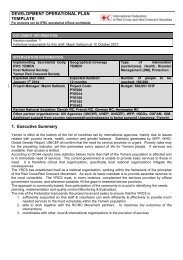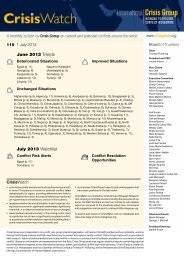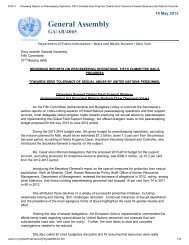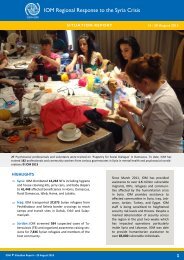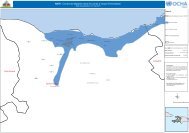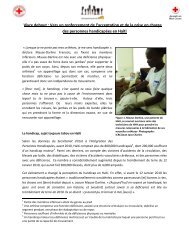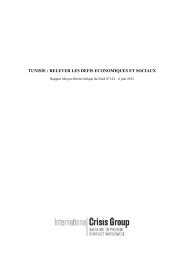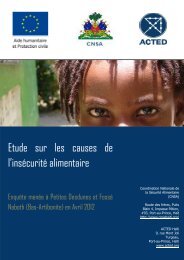SOMALI NUTRITION STRATEGY 2011 – 2013 - ReliefWeb
SOMALI NUTRITION STRATEGY 2011 – 2013 - ReliefWeb
SOMALI NUTRITION STRATEGY 2011 – 2013 - ReliefWeb
You also want an ePaper? Increase the reach of your titles
YUMPU automatically turns print PDFs into web optimized ePapers that Google loves.
16 In Somaliland and to a lesser extent Puntland, more or less stable government institutions have<br />
been formed providing greater opportunities for partnerships. However as yet, capacity, coordination<br />
and policy or regulatory framework is limited. The relative peace and stability allows greater access<br />
for intervention, monitoring and supervision. In the north, support needs to focus on the increasing<br />
numbers of IDPs who, despite some improvement in acute malnutrition rates between Post Gu 09<br />
and Post Deyr 09/10 seasonal assessments (median GAM down from 20% to 16.7%, median SAM<br />
down from 4.8% to 4.2%) remain one of the most nutritionally vulnerable group of all livelihoods, with<br />
the highest median stunting rate of 25%.<br />
4.4 Operational research<br />
Although extensive information is gathered through FSNAU, FEWSNET, WFP food security and<br />
vulnerability assessments, gaps remain in knowledge of many areas including:<br />
• local availability of nutrient dense foods, of food habits, taboos and other factors that influence<br />
consumption of nutrient dense foods,<br />
• enabling factors and barriers to optimal breast feeding, young child and maternal feeding practices,<br />
• economic and cultural dynamics of breast milk substitutes,<br />
• opportunities for engagement with private sector in areas of breast milk substitutes and food<br />
fortification,<br />
• innovative population based delivery mechanisms for micronutrient supplementation, deworming,<br />
nutrition education and behaviour change communication.<br />
In each of these areas, operational research has been identified as a key activity by which to inform<br />
and guide appropriate intervention and links with achieving output 2.2.<br />
4.5 Technical support<br />
There will be a need to commission consultants with particular expertise in certain areas including<br />
economics, food fortification, infant and young child feeding, to provide clearer understanding of<br />
current situation, identify potential for future interventions and formulate action plans.<br />
4.6 Behaviour Change Communication<br />
Many of the output results require attitude<br />
and behaviour change on an individual<br />
and community basis (early initiation of<br />
and exclusive breastfeeding for 6 months,<br />
optimal complementary feeding practices,<br />
food safety, increased dietary diversity,<br />
hygiene practices, demand for micronutrient<br />
supplementation and reduction of practices<br />
inhibiting micronutrient absorption,<br />
appropriate health and nutrition seeking<br />
behaviours). There is often overlap with<br />
priorities of other sectors eg promotion<br />
of food safety goes hand in hand with<br />
good hygiene practices. In response, a<br />
comprehensive and integrated behaviour<br />
change communication strategy approach is<br />
needed with the development of key simple<br />
Breastfeeding Counselling, IDPs, Hargeisa,<br />
UNICEF Somalia, Iman Morooka<br />
messages and the identification of delivery channels that are appropriate and effective in the Somali<br />
context. Messages should be communicated through more than one channel for maximum effect:<br />
on an individual basis through interpersonal counselling by community health workers and breast<br />
feeding counsellors, and mobilising communities through mosques, schools and local institutions<br />
and mass media campaigns.




